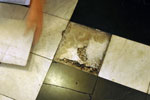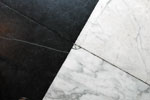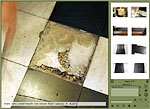Our Lord in the Attic: A Case Study
Stone floors
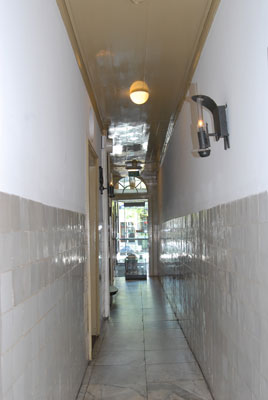 There are several spaces with stone floors, including: the sael; the Leeuwenberg room; and the corridor on the ground floor, leading from the front door towards the back of the main house.
There are several spaces with stone floors, including: the sael; the Leeuwenberg room; and the corridor on the ground floor, leading from the front door towards the back of the main house.
The floor in the sael was laid between 1661 and 1663. The floor mirrors the layout of the ceiling above in a geometrical pattern in black on white. The black marble came from Belgium, while the white marble came from Italy. The floor in the Jaap Leeuwenberg room is similar in technique and materials to this floor. It was rediscovered during the restoration of 1954-1960. The floor in the hallway has no pattern and is of plain white marble.
The visitors are allowed to walk over these floors. They are a unique feature in this building and considered of great importance. The stone floors are original, although maintenance work has been carried out throughout the centuries.
Description
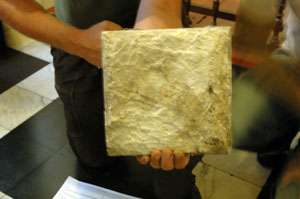 The marble floor was traditionally constructed by laying the marble and stone slabs on a bed of ground seashells. The shell bed, sometimes mixed with lime, is approximately 3 cm thick and is placed directly on the wooden floor, which was often lowered to allow for this thickness. The shells spread out and level the wooden floor surface. Dimensional changes of the wooden floor are also compensated for by the shell bed. The marble slabs were placed loose on top of the bed of shells. The bottom of a slab is curved and fairly rough, to create a good grip in the bed of shells. The bed of shells would probably have been refilled over the years, as shells crushed and became powdery. Traditionally, these types of floors were usually fully lifted and re-laid once every 100 years. Some slabs have been replaced over the years. In the sael the most recent intervention was in 2000, when a few slabs were repaired and fixed in place.
The marble floor was traditionally constructed by laying the marble and stone slabs on a bed of ground seashells. The shell bed, sometimes mixed with lime, is approximately 3 cm thick and is placed directly on the wooden floor, which was often lowered to allow for this thickness. The shells spread out and level the wooden floor surface. Dimensional changes of the wooden floor are also compensated for by the shell bed. The marble slabs were placed loose on top of the bed of shells. The bottom of a slab is curved and fairly rough, to create a good grip in the bed of shells. The bed of shells would probably have been refilled over the years, as shells crushed and became powdery. Traditionally, these types of floors were usually fully lifted and re-laid once every 100 years. Some slabs have been replaced over the years. In the sael the most recent intervention was in 2000, when a few slabs were repaired and fixed in place.
The bed of shells would probably have been refilled over the years, as shells crush and become powdery. Traditionally, these types of floors were usually fully lifted and re-laid once every 100 years. Some slates have been replaced over the years, most recent intervention in 2000, when a few slates were repaired and fixed in place.
Listen to the architect discussing the stone floor in the sael:
Example of damage to stone floor in the sael.
Launch image viewer of the stone floor in the sael
![]() damage to the stone floor in the sael (recorded in 2006) (PDF, 50KB)
damage to the stone floor in the sael (recorded in 2006) (PDF, 50KB)
![]() damage to the stone floor in the Jaap Leeuwenberg room (recorded in 2006) (PDF, 50KB)
damage to the stone floor in the Jaap Leeuwenberg room (recorded in 2006) (PDF, 50KB)
Condition of the stone floors
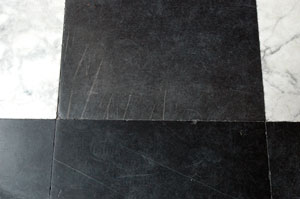 The stone floors are susceptible to wear and tear, not so much in the abrasion of the material, which is relatively strong, but more in damage related to the stability of the floor. As the seashell bed is crushed over time, the curved slates will start rocking as ones walks over the floor, resulting in chipping at the edges and eventually cracking of the slates. Another contributing factor to the overall stability of the structure is the wooden floor underneath– in the sael the floor is sagging towards the alley and the bed of seashells is not compensating for this deformation. At the moment, the slabs are still secured in the shell bed. In order to avoid unnecessary damage in the future, maintaining a stable shell bed is crucial.
The stone floors are susceptible to wear and tear, not so much in the abrasion of the material, which is relatively strong, but more in damage related to the stability of the floor. As the seashell bed is crushed over time, the curved slates will start rocking as ones walks over the floor, resulting in chipping at the edges and eventually cracking of the slates. Another contributing factor to the overall stability of the structure is the wooden floor underneath– in the sael the floor is sagging towards the alley and the bed of seashells is not compensating for this deformation. At the moment, the slabs are still secured in the shell bed. In order to avoid unnecessary damage in the future, maintaining a stable shell bed is crucial.
In terms of material strength: the white marble is more vulnerable then the black stone - it will break more easily and is more susceptible to abrasion and staining (it is more porous).
To summarize, different types of damage can be observed (this was recorded in a condition assessment in 2006):
- Scratching caused by sharp heels, or possible little stones that get stuck in visitor's shoe soles;
- Chipping along edges and in corners of the slabs;
- Some stone slabs have cracked;
- In some areas the stone slabs do not connect smoothly;
- Some staining.
The floors are vacuum cleaned with a frequency depending on visitation, varying from daily in busy times to once a week in quieter periods. Sometimes the floors are cleaned with a damp cloth and \x91Ecover\x92, a biodegradable soap, when necessary and often only locally. The frequency of damp cleaning varies with the weather and seasons, but is on average once a month. When it is wet outside, more dirt is brought in.
